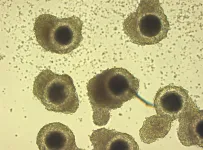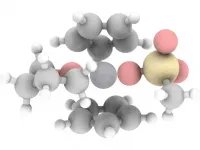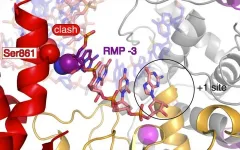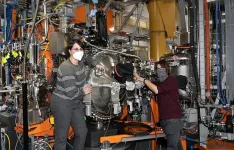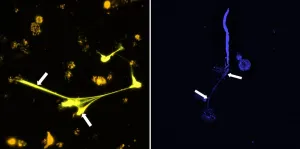(Press-News.org) According to current studies, the COVID-19 disease which is caused by the SARS-CoV-2 coronavirus comprises at least five different variants. These differ in how the immune system responds to the infection. Researchers from the German Center for Neurodegenerative Diseases (DZNE) and the University of Bonn, together with other experts from Germany, Greece and the Netherlands, present these findings in the scientific journal "Genome Medicine". Their results may help to improve the treatment of the disease.
Infection with SARS-CoV-2 can manifest in different ways: Many of those affected do not even seem to notice the presence of the virus in their bodies. In other cases, the effects can include flu-like symptoms and neurological disorders to severe and even life-threatening pneumonia. "The classification of COVID-19 into mild and severe courses falls short. The disease is much more diverse, and for each affected person, one certainly would want a therapy that is tailored to fit. What helps one person may be ineffective for another," said Dr. Anna Aschenbrenner, a scientist of the LIMES Institute at the University of Bonn and the DZNE's Systems Medicine division. "In this respect, it is obvious to want to understand what underlies these differences. If we can pin them down to scientific criteria and categorize patients accordingly, this increases the chances of effective treatment. We therefore took a look at the immune system. Because many studies are indicating that its response to infection with SARS-CoV-2 plays a crucial role in the course of COVID-19," said Aschenbrenner, who is a member of the Cluster of Excellence "ImmunoSensation" of the University of Bonn.
International Cooperation
In light of this, a team led by Anna Aschenbrenner, along with colleagues in Germany and abroad, analyzed the blood of people with and without COVID-19. The samples came from a total of 95 people distributed among Bonn, Athens and Nijmegen. The research was done in collaboration with the "German COVID-19 OMICS Initiative" (DeCOI) - a network of German universities and research institutions. In Bonn, the DZNE and the University of Bonn were involved, as well as the University Hospital. Partners abroad were the Attikon University Hospital as well as the Sotiria Hospital in Athens, Greece, and the Radboud University Medical Center in Nijmegen in the Netherlands.
For each patient, the so-called transcriptome of the immune cells in the blood was determined. This requires the analysis of large amounts of data using bioinformatics methods. Based on the molecular fingerprint generated in this way, the researchers were able to identify which genes within the immune cells were switched on or off. Such signatures of gene activity - known as "expression patterns" - provide information about the condition of cells and thus about their properties and functions, which can change depending on the situation.
Interestingly, the picture obtained in this way was largely determined by the family of "neutrophils", which are the most abundant of the so-called white blood cells and quite up front in the reaction chain of the immune response. These cells are thus mobilized very early to defend against infections. They act upon the formation of antibodies and, moreover, on other cells that contribute to immunity.
Five Manifestations
"First of all, it is important to note that the expression patterns of immune cells in people with COVID-19 differ fundamentally from those in healthy individuals. The gene activity we can detect in the blood is strongly altered. But there are also striking differences among patients. On this basis, we have identified five different groups. We refer to them as molecular phenotypes," said Dr. Thomas Ulas, an expert in bioinformatics at the DZNE. "Two of them represent severe disease courses. The others have more moderate symptoms." The classification was based solely on transcriptome data. Only in retrospect, molecular phenotypes were matched to registered clinical courses.
COVID-19 Is Different
The researchers used their findings to compare COVID-19 with other diseases and also with data from healthy individuals. For this purpose, they were able to draw on data from the "Rhineland Study" - a population study conducted by the DZNE in the Bonn area - as well as on data from scientific databases. For the comparison, a large spectrum of diseases was considered: including viral infections such as influenza, infections with HIV and Zika, bacterial infections such as tuberculosis and bacterial sepsis, and inflammatory diseases such as rheumatoid arthritis. "All five COVID-19 phenotypes are different from the other diseases we studied," Ulas said, summing up the findings. "Apparently, COVID-19 has a unique biology that is reflected in the gene activity of immune cells in the blood. Insofar, expression analysis could be used to diagnose COVID-19. This would be an alternative or complement to current methods."
Searching for Drugs
The scientists also searched for potential drugs against COVID-19. For this, they drew on the effects registered in databases of around 900 approved drugs on the expression patterns of cells. "We calculated which pharmaceuticals could counteract the altered gene activity profiles of the individual COVID-19 phenotypes," said Aschenbrenner. On this basis, drug candidates for therapy were identified. "Already in April of last year, we calculated a potential efficacy for example for dexamethasone and baricitinib in one of the patient groups with severe course that we identified. These types of analyses, it must be clearly stated, are not treatment recommendations. They do, however, very much provide starting points for therapy development, which then need to be tested in appropriate trials. In the case of dexamethasone and baricitinib, our predictions turned out to be correct. This is an indication of the strength of our approach of using blood transcriptomes to better characterize and classify patients."
INFORMATION:
Original publication
Disease severity-specific neutrophil signatures in blood transcriptomes stratify COVID-19 patients, Aschenbrenner et al., Genome Medicine (2021), DOI: 10.1186/s13073-020-00823-5,
URL: https://genomemedicine.biomedcentral.com/articles/10.1186/s13073-020-00823-5
On the German Center for Neurodegenerative Diseases (DZNE)
The DZNE investigates all aspects of neurodegenerative diseases (such as Alzheimer's and Parkinson's and Amyotrophic lateral sclerosis) in order to develop novel approaches of prevention, treatment, and health care. The DZNE is comprised of ten sites across Germany and cooperates closely with universities, university hospitals, and other institutions on a national and international level. The DZNE is a member of the Helmholtz Association. Website: http://www.dzne.de/en
In order to achieve the goals of the Paris Agreement, the world must reach net-zero carbon emissions by 2050. Carbon pricing is viewed by many governments and experts as the most important climate policy instrument. However, a new study shows that carbon pricing has been less effective as a driver of technological change than was previously anticipated.
While the introduction of carbon pricing systems has led to emissions reductions in some countries, they have not significantly stimulated technological change. Bringing about the necessary transformation will require sector-specific promotion of climate-friendly technologies, for example ...
For this specific method of cryopreservation, oocytes are collected directly after an animal is castrated or deceased and immediately frozen at -196°C in liquid nitrogen. This technique allows the storage of oocytes of valuable animals for an unlimited time, so that they can be used to produce offspring with the help of assisted reproduction techniques. The aim is to further improve and apply these methods to save highly endangered species such as the Asiatic lion from extinction. The current research on African lions as a model species is an important step in this direction. The results are reported in the scientific journal Cryobiology.
Lion oocytes are presumed to be very sensitive to chilling due to their high lipid content, resulting ...
Acetals are important chemical compounds that are used, for example, in the production of certain medical agents. A new method now makes their synthesis easier and more environmentally friendly. Chemists at the University of Bonn have developed and optimized the sustainable catalytic process. State-of-the-art computer simulations were also used. The reaction is based on a mechanism that frequently occurs in nature, but has rarely been used in chemical synthesis up to now. The results are published in the journal Angewandte Chemie.
The key step in the production of acetals is the bonding of two oxygen ...
Remdesivir is the first drug against Covid-19 to be conditionally approved in Europe and the United States. The drug is designed to suppress the rapid replication of the SARS-CoV-2 virus in human cells by blocking the viral copying machine, called RNA polymerase. Researchers at the Max Planck Institute (MPI) for Biophysical Chemistry in Göttingen and the University of Würzburg have now elucidated how remdesivir interferes with the viral polymerase during copying and why it does not inhibit it completely.
"After complicated studies, we come to a simple conclusion," Max Planck Director Patrick ...
UPTON, NY--Marking a major achievement in the field of spintronics, researchers at the U.S. Department of Energy's (DOE) Brookhaven National Laboratory and Yale University have demonstrated the ability to control spin dynamics in magnetic materials by altering their thickness. The study, published today in Nature Materials, could lead to smaller, more energy-efficient electronic devices.
"Instead of searching for different materials that share the right frequencies, we can now alter the thickness of a single material--iron, in this case--to find a magnetic medium that will enable the transfer of information across a device," said Brookhaven physicist and principal investigator Valentina ...
Scientists have discovered a molecule that can selectively kill cells of a hard-to-treat subtype of breast cancer, which could lead to a new therapy.
The study, led by researchers at RCSI University of Medicine and Health Sciences, is published in the current edition of Science Advances.
Triple negative breast cancer is a subtype of breast cancer which is mainly treated with chemotherapy. Unfortunately, up to 70% of patients with this form of breast cancer develop resistance to treatment.
The researchers tested different molecules to see if they could selectively kill the cells of this type of breast cancer while sparing normal ...
As hemp begins to reemerge as an important crop in the United States, scientists are beginning research into the diseases that might prevent the crop from flourishing. A study published in the December issue of Plant Health Progress is one of the first to study the potential disease and disorder limitations for hemp production in the southeastern United States.
Lindsey Thiessen, a plant pathologist at North Carolina State University, worked with colleagues to evaluate hemp samples from North Carolina and observed 16 different diseases. They found Fusarium flower blight most consistently followed by Helminthosporium ...
A new study published in PNAS finds that aid provided by the United Nations (UN) in the aftermath of climate-related disasters is driven by humanitarian need rather than by strategic donor interests. The results underline the importance of climate-related hazards for understanding aid disbursements.
The study 'Humanitarian need drives multilateral disaster aid' provides the first estimation of UN climate-related disaster aid worldwide. Although it cannot be entirely ruled out that powerful donor states' interests shape UN aid flows, the UN seems able to fend off donor states' strategic ...
Filariae, slender but sometimes up to 70 centimeters long nematodes, can set up residence in their host quite tenaciously and cause serious infectious diseases in the tropics. The tiny larvae of the worms are usually transmitted from person to person by mosquitoes, which pick up the larvae from the blood or subcutaneous tissue when they bite and deposit them in the vessels or tissues of their next victim. Researchers led by the University of Bonn (Germany) have now investigated a mechanism by which the immune system attacks the filariae. Certain immune cells, the eosinophil granulocytes, release DNA that forms a kind of web around the larvae and traps them. The researchers ...
Our brains experience significant changes in blood flow and neural activity during sleep, according to Penn State researchers. Such changes may help to clean out metabolic brain waste that builds up during the day.
"We studied the sleep patterns of mice during both rapid eye movement and non-rapid eye movement sleep stages, as well as in different alertness states," said Patrick Drew, Huck Distinguished Associate Professor of Engineering Science and Mechanics, Neurosurgery and Biomedical Engineering.
Mice were chosen for the study because of their brains' remarkable similarity with human brains, said the researchers.
In both mice and humans, non-REM sleep ...
